#Albert S. D'Agostino
Text






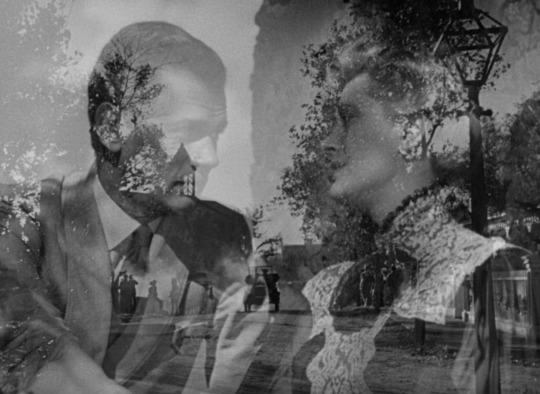




The Magnificent Ambersons (Orson Welles, 1942).
#the magnificent ambersons#orson welles#fredd fleck#robert wise#joseph cotten#dolores costello#anne baxter#tim holt#jack moss#mark robson#stanley cortez#jack mackenzie#Albert S. D'Agostino#Darrell Silvera
52 notes
·
View notes
Text

Born to Be Bad (Nicholas Ray, 1950)
Cast: Joan Fontaine, Robert Ryan, Zachary Scott, Joan Leslie, Mel Ferrer, Harold Vermilyea, Virginia Farmer. Screenplay: Edith Sommer, Charles Schnee, based on a novel by Anne Parrish. Cinematography: Nicholas Musuraca. Art direction: Albert S. D'Agostino, Jack Okey. Film editing: Frederic Knudtson. Music: Friedrich Hollaender.
4 notes
·
View notes
Photo


Out of the Past, 1947
#Out of the Past#Jacques Tourneur#Nicholas Musuraca#Albert S. D'Agostino#Jack Okey#Darrell Silvera#Robert Mitchum#Jane Greer#1947
89 notes
·
View notes
Photo


Los Angeles Noir: Murder, My Sweet (Edward Dmytryk, 1944) | Art direction by Carroll Clark and Albert S. D'Agostino
gif source +
77 notes
·
View notes
Text
The Spiral Staircase (Robert Siodmak, 1945)
Sí, puede decirse, como se ha escrito y se volverá a decir, que The Spiral Staircase congrega casi todos los que (retrospectivamente) cabría considerar como tópicos del cine de terror y de suspense, desde oportunas lluvias y truenos hasta animales con los que se tropieza, desde viento y ventanas que se abren a ramas que se mueven, chirridos y otros elementos típicos de una lista casi interminable, y que casi sin excepción hacen acto de presencia (oportuna y funcional) en esta eficacísima y muy disfrutable película de género más fluctuante que impreciso pero de gran precisión en su factura, realizada con impecable maestría por Robert Siodmak, un enorme técnico que a menudo añadía imaginación e inspiración a su casi invariable competencia y a su no desdeñable sentido plástico.
Y señalaba antes (discretamente) que esos reproches son sobre todo retrospectivos, porque a mi entender su influencia, tanto en películas inmediatamente posteriores (pienso en algunos planos de Notorious, Encadenados, 1946) como en otras ya bastante alejadas en el tiempo (como Psycho, Psicosis, 1960, nuevamente de Hitchcock, o Bunny Lake is Missing, El rapto de Bunny Lake, 1965, de Otto Preminger), sin contar otras menos ilustres y que se limitaron a copiar (a menudo mal, de modo más efectista que efectivo) algunos o muchos de los aciertos de este film de Siodmak en el que, por el contrario, no sobra un plano –salvo unos cuantos, demasiados, del “ojo del asesino en serie”, curiosamente uno de los del propio Siodmak– ni pesa un segundo vacío, ni transcurre un minuto sin que algo nos inquiete o sorprenda, tentándonos a sacar conclusiones que una vez tras otra se revelan precipitadas, sin fundamento, provisionales o dudosas, y estas mismas percepciones erróneas las padecen prácticamente todos los abundantes personajes que pueblan la oscura y tenebrosa mansión de los Warren, una familia poco y mal avenida y no poco desequilibrada, propia de los relatos más o menos góticos, románticos o fantásticos que tanto abundan en la literatura anglosajona.
Porque, conviene advertirlo, aunque formalmente tenga puntos en común con ese género tan frecuentemente practicado por Siodmak, La escalera de caracol no es cine “negro”, sino una película “de época”, temporalmente situada en los primeros años del siglo XX, con calesas, teléfonos y películas que aún resultaban novedosas (como The Sands of Dee, 1912, de D.W. Griffith), y que indirectamente aborda –a través de un personaje que odia y desprecia toda deformidad o defecto físico, naturalmente sin darse cuenta de que mentalmente él está mucho peor que cualquiera de sus víctimas– la política de raza pura y superior y la tendencia a la eugenesia, la esterilización y la eutanasia de todos aquellos que consideraba enfermos o débiles que había predicado y practicado el nazismo (no se olvide que, aunque estrenada en 1946, fue terminada en 1945).
Por último, no conviene olvidar que, si el talento y la precisión de la puesta en imágenes de Siodmak es decisiva en el éxito de la película, es una producción de Dore Schary para la RKO, con el concurso de varios de los técnicos fundamentales de esa modesta productora, como el genial director de fotografía Nicholas Musuraca, el músico Roy Webb, los montadores Harry Gerstad y Harry Marker, los directores artísticos y decoradores Albert S. D'Agostino, Jack Okey y Darrell Silvera, además de contar con el guionista Mel Dinelli (el de House by the River, 1949/50, de Fritz Lang) adaptando (con muchas innovaciones) una novela de Ethel Lina White, la autora de The Lady Vanishes (Alarma en el expreso, 1938) de Hitchcock y de The Unseen (Misterio en la noche, 1944) de Lewis Allen. Sin olvidar a la excelente actriz Dorothy McGuire, en un papel sin diálogo ni voz, y a un montón de competentes secundarios.
Miguel Marías
Cineclub Santander, julio-2020
0 notes
Photo
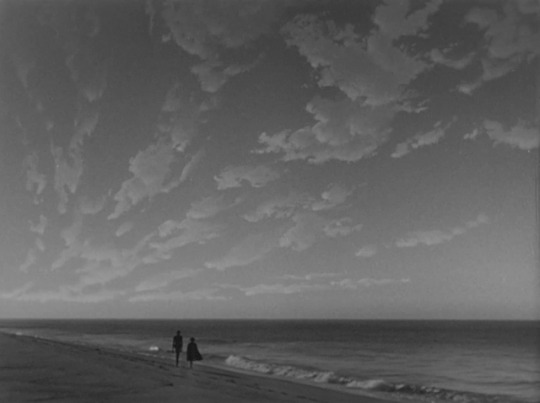

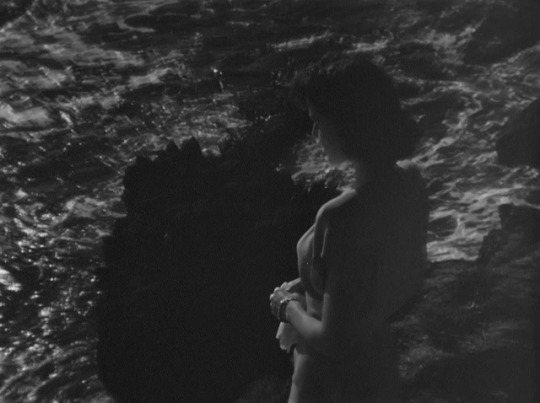


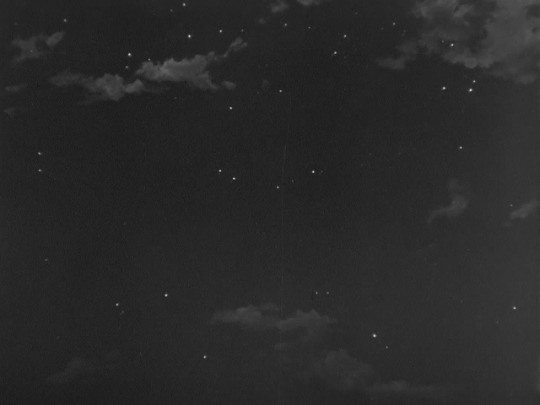


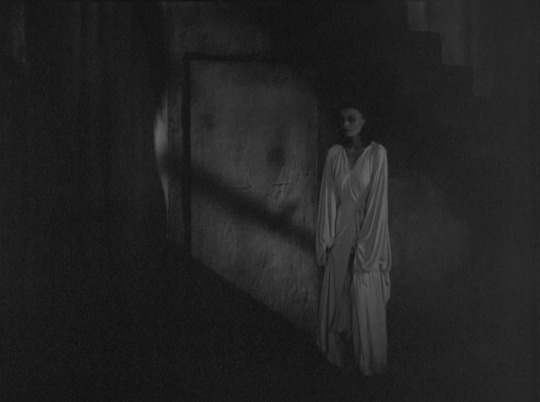

I Walked with a Zombie (Jacques Tourneur, 1943).
#i walked with a zombie#i walked with a zombie (1943)#jacques tourneur#val lewton#j. roy hunt#mark robson#albert s. d'agostino#darrell silvera
42 notes
·
View notes
Photo


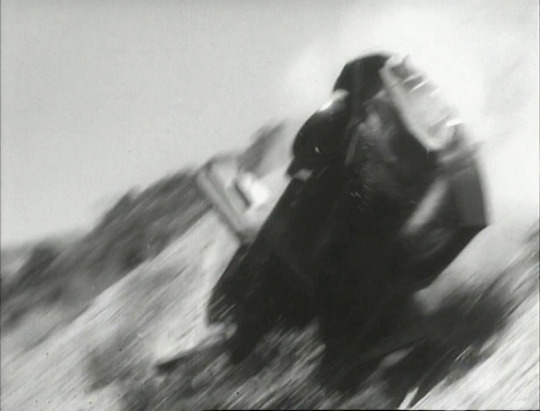


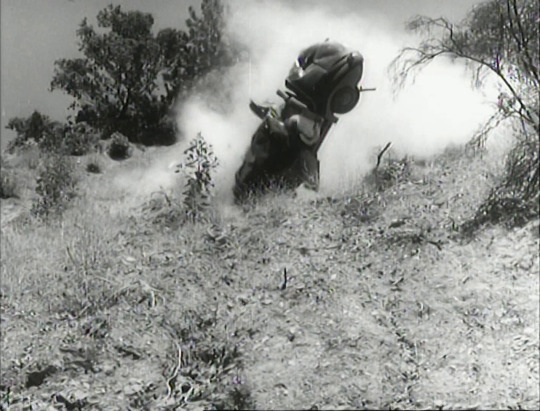


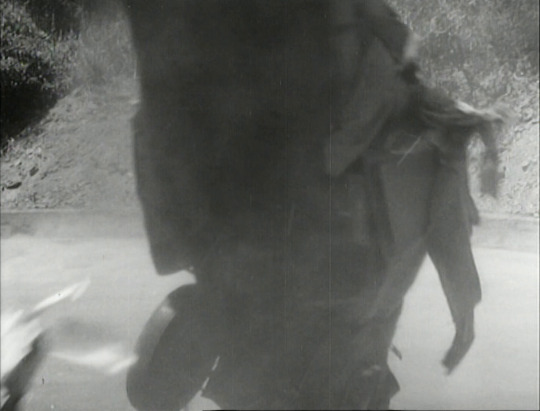
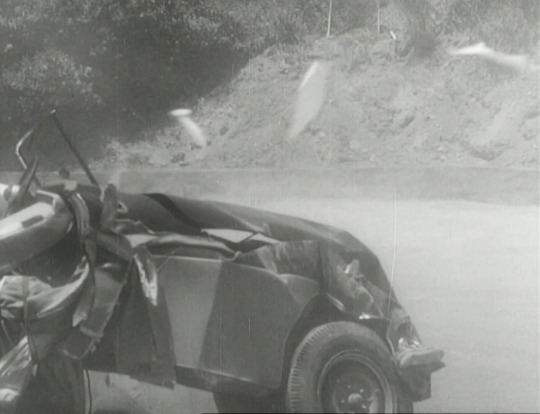
Angel Face (Otto Preminger, 1952).
#angel face#angel face (1952)#otto preminger#harry stradling sr.#frederic knudtson#carroll clark#albert s. d'agostino
26 notes
·
View notes
Text

Bela Lugosi and Boris Karloff in The Raven (Lew Landers, 1935)
Cast: Bela Lugosi, Boris Karloff, Lester Matthews, Irene Ware, Samuel S. Hinds, Spencer Charters, Inez Courtney, Ian Wolfe, Maidel Turner. Screenplay: David Boehm. Cinematography: Charles J. Stumar. Art direction: Albert S. D'Agostino. Film editing: Albert Akst. Music: Clifford Vaughan.
The Criterion Channel includes The Raven in its collection of pre-Code horror movies, but in fact the movie started filming after the Production Code was introduced, and director Lew Landers had to negotiate over details in the script. The enforcers were nervous about "excess horror," and in particular wanted the film not to show any details of the operation that Dr. Vollin (Bela Lugosi) performs on Bateman's (Boris Karloff) face. Even so, censors took aim at what they called "horror for horror's sake," and The Raven was banned in several countries. The defense from Universal Studios that the movie was a tribute to Edgar Allan Poe impressed nobody. It's still a fairly creepy movie, largely because the filmmakers managed to include some torture devices from Poe's stories like "The Pit and the Pendulum." The poem "The Raven" mainly gives Dr. Vollin an excuse to explain to everyone that the bird is a symbol of death, but it also prompts a rather silly dance recital by the object of Vollin's obsession, Jean Thatcher (Irene Ware). Vollin is a neurosurgeon who saves Jean's life after she's injured in an automobile accident. She's engaged to another surgeon, Dr. Halden (Lester Matthews), and when her father, Judge Thatcher (Samuel S. Hinds), stymies Vollin's interest in Jean, Vollin takes his revenge. He has a collection of torture devices and an old house outfitted with gimmicks like a bedroom on an elevator and a secret room whose walls close in on people trapped in it. Karloff's Bateman is a bank robber who escaped from San Quentin and is on the run, so in the guise of giving him plastic surgery to change his identity, Vollin instead disfigures him, and then makes him play servant at a house party to which Halden, the Thatchers, and various other guests are invited. Madness ensues. The movie's chief virtue is brevity -- it runs 61 minutes -- so it never gets tedious even though it also never gets either scary or plausible.
2 notes
·
View notes
Text

George Brent, Paul Lukas, and Hedy Lamarr in Experiment Perilous (Jacques Tourneur, 1944)
Cast: Hedy Lamarr, George Brent, Paul Lukas, Albert Dekker, Carl Esmond, Olive Blakeney, George N. Neise, Margaret Wycherly. Screenplay: Warren Duff, based on a novel by Margaret Carpenter. Cinematography: Tony Gaudio. Art direction: Albert S. D'Agostino, Jack Okey. Film editing: Ralph Dawson. Music: Roy Webb.
Cary Grant was the original choice to play the male lead in Experiment Perilous and Gregory Peck was the second. If the role had gone to either of them, the film might be remembered as more than just the other gaslighting movie of 1944, but it has been eclipsed by George Cukor's Gaslight. The part of the psychiatrist Huntington Bailey went to the stolid old reliable George Brent. Dr. Bailey gets caught up in the drama of the Bederaux family when he has a chance encounter on a train with the slightly dotty Clarissa (Cissie) Bederaux (Olive Blakeney), who tells him she's writing the biography of her brother Nick (Paul Lukas), who has a beautiful wife named Allida (Hedy Lamarr). Bailey is intrigued, but not much more, until a mixup in luggage puts him in possession of one of Clarissa's bags. That, and the enthusiasm of his artist friends Clag (Albert Dekker) and Maitland (Carl Esmond) for Allida's beauty, draws him into the Bederaux circle and arouses his suspicions that Allida is not the mentally fragile woman that her husband and others say she is. When he learns that Cissie has died of a heart attack, he opens her valise and finds the manuscript of her biography and her diary, confirming his suspicion -- and putting him in jeopardy. This is solid melodrama stuff, and director Jacques Tourneur, who directed the Val Lewton romantic horror movies Cat People (1942) and I Walked With a Zombie (1943), knows just what to do with it. He's hindered a little by an over-complicated screenplay based on a novel by Margaret Carpenter, which necessitates a lot of flashbacks and switches in point of view, so the film doesn't proceed as smoothly as it might. But he maintains the right atmosphere as the plot moves to its resolution, which involves literally lighting gas as well as gaslighting. There's a goopy happy-ending coda to the main story that strikes the wrong note for the film, but Experiment Perilous deserves to be known as more than an also-ran.
4 notes
·
View notes
Text

Simone Simon in Cat People (Jacques Tourneur, 1942)
Cast: Simone Simon, Kent Smith, Tom Conway, Jane Randolph, Jack Holt. Screenplay: DeWitt Bodene. Cinematography: Nicholas Musuraca. Art direction: Albert S. D'Agostino, Walter E. Keller. Film editing: Mark Robson. Music: Roy Webb.
Cat People is so fraught with subtext about the fear of female sexuality that it's amazing that critics once treated it as a mere "horror movie," even while admitting that it was an effective one. Starting with the image drawn by Irena (Simone Simon) of a panther impaled on a sword, which is a version of the even more phallocentric statue in her apartment, it's clear that director Jacques Tourneur, screenwriter DeWitt Bodeen, and producer Val Lewton have more on their minds (or subsconsciousnesses) than just spooking the audience. But then subtext was about the only way filmmakers could get away with sex under the Production Code, even when the point is that Irena and her husband (Kent Smith) are not having sex because she's afraid she'll rip him to shreds if they so much as kiss. I have some reservations about the horror films produced by Lewton, one of the few producer-auteurs, partly because they're often more fun to talk about than to watch.
3 notes
·
View notes
Text

Ray Milland and Carole Lombard in Mr. & Mrs. Smith (Alfred Hitchcock, 1941)
Cast: Carole Lombard, Robert Montgomery, Gene Raymond, Jack Carson, Philip Merivale, Lucile Watson, William Tracy, Charles Halton, Esther Dale. Screenplay: Norman Krasna. Cinematography: Harry Stradling Sr.. Art direction: Van Nest Polglase, Albert S. D'Agostino. Film editing: William Hamilton. Music: Edward Ward.
If Alfred Hitchcock's name were not attached to Mr. & Mrs. Smith, would we remember it at all today? Perhaps as one of the last films of Carole Lombard -- it was the last released before her death in January 1942, though the posthumously released To Be or Not to Be (Ernst Lubitsch, 1942) was the last one she completed filming. Or perhaps as one of the lesser examples of the romantic/screwball comedy genre that flourished in the 1930s and '40s. But even hardcore Hitchcockians find it difficult to fit it into the director's canon. Hitchcock had said he wanted to work with Lombard, and when Lombard liked Norman Krasna's story and screenplay, the teaming was put into play. Lombard and Robert Montgomery play Ann and David Smith, who discover that their three-year-old marriage is invalid, owing to a legal technicality. Complications ensue, especially when David doesn't rush into remarriage as quickly as Ann likes. She kicks him out of the apartment, and then his law partner, Jeff Custer (Gene Raymond), makes a play for her affections. Lombard is very much at home in this kind of comedy, and Montgomery is good at it too. The weak link is Raymond, who has the kind of role, the "other man" patsy, at which actors like Ralph Bellamy in The Awful Truth (Leo McCarey, 1937) and His Girl Friday (Howard Hawks, 1940) and John Howard in The Philadelphia Story (George Cukor, 1940) excelled. Raymond plays his part with a pinched, rather prissy manner that hardly sits well with the fact that he's supposed to have been the best fullback at the University of Alabama. In fact, the character seems to have been coded as latently gay: Witness Lombard's reaction when Ann learns that he decorated his own very tasteful apartment. Much of the film skirts around matters forbidden by the Production Code, including whether the now-unmarried Smiths should sleep together, which a director like Lubitsch or Hawks would have treated with more wit and finesse than Hitchcock does. This was only his third film made in Hollywood, and it was his first with a completely American setting; the first two, Rebecca (1940) and Foreign Correspondent (1940), were set in Europe and England. His unfamiliarity with American idiom shows up particularly in his treatment of the Alabama football jock Jeff and his parents (Philip Merivale and Lucile Watson), proper Southerners who are shocked at the suggestion that Ann has been sleeping with David. But whenever Hitchcock is working with Lombard and Montgomery, especially using Lombard's great gift for uninhibited physical comedy, the movie comes to fitful life.
2 notes
·
View notes
Photo





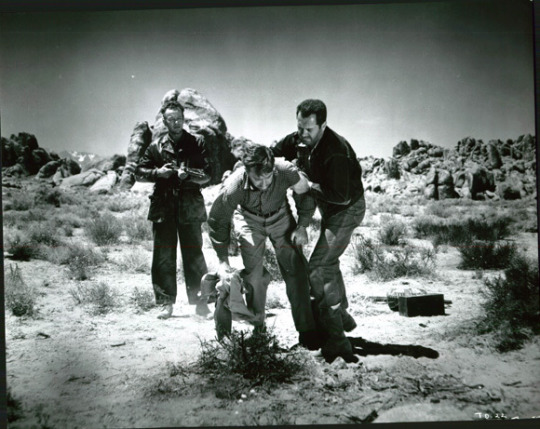



The Hitch-Hiker (Ida Lupino, 1953)
Cast: Edmond O'Brien, Frank Lovejoy, William Talman, José Torvay, Sam Hayes, Wendell Niles, Jean Del Val, Clark Howat, Natividad Vacío. Screenplay: Collier Young, Ida Lupino, Robert L. Joseph, Daniel Mainwaring. Cinematography: Nicholas Musuraca. Art direction: Albert S. D'Agostino, Walter E. Keller. Film editing: Douglas Stewart. Music: Leith Stevens.
The thing I admire most about The Hitch-Hiker is its economy. It doesn't waste time giving us, for example, the backstory of Roy Collins and Gilbert Bowen, the two guys played by Edmond O'Brien and Frank Lovejoy. Lesser films would have given us scenes in which they bid farewell to their wives and children, trying to establish them as good guys in the hands of a psychopath -- we catch on to that fast enough without sentimental ties back home. Ida Lupino doesn't need to mess around with unnecessary sympathy for them. In fact, we're aware that they're not entirely paragons of virtue: They bicker, for example, about where they're going to spend their little time away from their wives, and there's a suggestion that they're glad to get away from home and family -- it looks like they want a little more action than just fishing. Later, after they've been trapped by Emmett Myers (a wonderfully scary performance by William Talman that makes me regret he got forever stuck as Hamilton Burger, the loser D.A. on the Perry Mason TV series), they quarrel about how they might escape from his clutches -- at one point Bowen even slugs Collins, who is on the verge of hysterics. There are some flaws: It's never really clear why Myers doesn't just shoot at least one of them -- he doesn't really need both to complete his journey to Santa Rosalía. And I do think the film falls a little flat at the end when Myers is so easily captured, but not enough to mar the gritty whole of the movie. Lupino and cinematographer Nicholas Musuraca use the desert landscape to great effect: It provides both isolation and exposure. The Hitch-Hiker deserves its reputation well beyond its historical distinction as a film noir with an all-male cast directed by a (gasp!) woman.
8 notes
·
View notes
Photo
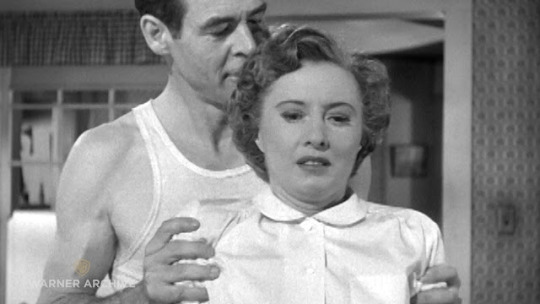
Robert Ryan and Barbara Stanwyck in Clash by Night (Fritz Lang, 1952)
Cast: Barbara Stanwyck, Paul Douglas, Robert Ryan, Marilyn Monroe, Keith Andes, J. Carrol Naish, Silvio Minciotti. Screenplay: Alfred Hayes, based on a play by Clifford Odets. Cinematography: Nicholas Musuraca. Art direction: Carroll Clark, Albert S. D'Agostino. Film editing: George Amy. Music: Roy Webb.
There's a wonderful moment in the middle of Fritz Lang's Clash by Night that almost makes up for the talky melodrama of the rest of the film: Stealing from the romantic gesture executed by Paul Henreid in Now, Voyager (Irving Rapper, 1942), Lang has Earl Pfeiffer (Robert Ryan) light two cigarettes at once and hand one of them to Mae Doyle (Barbara Stanwyck). She looks at it with distaste for a moment, then tosses it over her shoulder, takes out her own pack of cigarettes, and lights one herself. It's possible that the moment is spelled out in Alfred Hayes's screenplay, or in the play by Clifford Odets on which it's based, but it's the perfect embodiment of Stanwyck's great gift for playing women in charge. In fact, Stanwyck's character is hardly ever fully in charge -- Mae Doyle can't control her life because of the men in it, which she describes as either "all little and nervous like sparrows or big and worried like sick bears." The problem with Clash by Night is not the cast, which is uniformly watchable, or the direction, which does what it can with the material, particularly by exploiting the film's setting -- Monterey, the bay, the fishing fleet, and Cannery Row -- but the screenplay. It's full of Odets characters who can't resolve their internal conflicts but also can't stop talking about them. Even the secondary characters, like Jerry D'Amato's father and uncle, can't help putting in their two cents, often in florid Odetsian metaphor. The title of the film comes from Matthew Arnold's "Dover Beach," in which the speaker laments the loss of faith in a world that has "neither joy, nor love, nor light, / Nor certitude, nor peace, nor help for pain." It's a place where "ignorant armies clash by night." That bleak Victorian pessimism, however, doesn't translate very well to a story in which the clashing armies are men and women, a battle of the sexes that's a little too conventional in concept. Mae returns to her family home in Monterey, and immediately starts making a mess of things by attracting not only the good-hearted Jerry but also his cynical burnt-out friend Earl. Since Jerry is played by the somewhat schlubby Paul Douglas and Earl by the handsome Ryan, we can see immediately where this is going to go, and the wait for it to get there gets a little tedious. There's also a rather pointless secondary plot involving Mae's brother, Joe, and his girlfriend, Peggy, who are played by Keith Andes and Marilyn Monroe. The backstories that stars and their personae bring to the roles they play are often valuable. Here, however, Marilyn's presence in the cast has unbalanced our subsequent reaction to the film, which can never be watched without the irrelevant knowledge of the actress's skyrocketing career, troubled relationship with her directors (including Lang, who terrified her so much that she vomited before performing a scene), and pitiable demise. Peggy is a small role, and she plays it well, but it was never meant to be the principal reason many people watch Clash by Night.
2 notes
·
View notes
Photo

Kirk Douglas and Dewey Martin in The Big Sky (Howard Hawks, 1952)
Cast: Kirk Douglas, Dewey Martin, Elizabeth Threatt, Arthur Hunnicutt, Buddy Baer, Steven Geray, Henri Letondal, Hank Worden. Jim Davis. Screenplay: Dudley Nichols, Ray Buffum, DeVallon Scott, based on a novel by A.B. Guthrie Jr. Cinematography: Russell Harlan. Art direction: Albert S. D'Agostino, Perry Ferguson. Film editing: Christian Nyby. Music: Dimitri Tiomkin.
The Big Sky is a good Henry Hathaway or Budd Boetticher movie, except that it was made by Howard Hawks, from whom we have come to expect more. Hawks had just passed through one of the peak periods of his long career, with the sterling achievement of To Have and Have Not (1944), The Big Sleep (1946), and Red River (1948), and he was to return to form in Gentlemen Prefer Blondes (1953) and Rio Bravo (1959). But The Big Sky looks like a routine Western adventure in that company, even though it has some old Hawksian hands on board in screenwriter Dudley Nichols, cinematographer Russell Harlan, and composer Dimitri Tiomkin. It has the director's characteristic touches in places: overlapping dialogue and the usual male-bonding moments. Some of the latter, especially between Kirk Douglas's Jim Deakins and Dewey Martin's Boone Caudill, verge on the homoerotic, since Boone is given to wearing tight leather pants and both go around with their shirts flared open, making one scene look like it's taking place in a West Hollywood bar and not a St. Louis saloon. The absence of the usual "Hawksian woman," able to return wisecrack for wisecrack, is particularly noticeable. The only woman in the large cast is Elizabeth Threatt, playing an Indian woman named Teal Eye, who doesn't speak English. This was the only film appearance for Threatt, a model Hawks had spotted in a photograph. Her chief function in the film is to provide sexual tension among the members of a crew of fur traders making their way up the Missouri River and to spark a bit of rivalry between Jim and Boone. Teal Eye has been brought along on the expedition by Zeb Calloway (Arthur Hunnicutt) to act as a go-between with the Blackfoot tribe, to which she belongs. Also along for the journey is a somewhat addled Blackfoot known as Poordevil, played by Hank Worden, a regular member of John Ford's stock company who sometimes moonlighted for Hawks. The journey is interrupted by Indian attacks, river rapids, and the threats from a rival trading company, in scenes that are staged and shot well but never provide more than the routine excitement of the genre. Hunnicutt and Harlan received Oscar nominations for their work.
1 note
·
View note
Photo

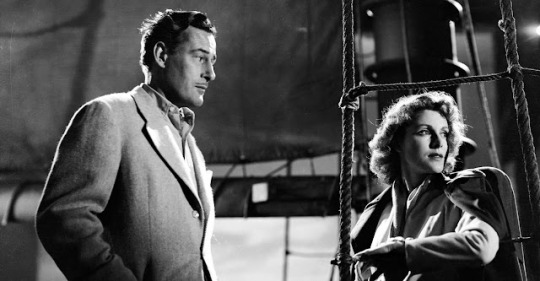



I Walked With a Zombie (Jacques Tourneur, 1943)
Cast: Frances Dee, Tom Conway, James Ellison, Edith Barrett, James Bell, Christine Gordon, Theresa Harris, Sir Lancelot, Darby Jones. Screenplay: Curt Siodmak, Ardel Wray, based on a story by Inez Wallace. Cinematography: J. Roy Hunt. Art direction: Albert S. D'Agostino, Walter E. Keller. Film editing: Mark Robson. Music: Roy Webb.
I feel a little sorry for the viewer who watches I Walked With a Zombie expecting the lurid thrills of The Walking Dead or even the campy ones of Hammer horror films, and encounters instead a moody, dreamlike tale that borrows heavily from Charlotte Brontë's Jane Eyre. The tone of the film is set at the very beginning, when the narrator -- Frances Dee's Betsy Connell -- says in a subdued, almost matter-of-fact manner, "I walked with a zombie." The low key restraint of her narration pervades the film, which has an insidious way of working on your nerves without subjecting them to sudden shocks. I like, too, the way in which the crime of slavery works its way into the fabric of the story as a source of horror. The coachman driving Betsy to Fort Holland reminds her of "the enormous boat [that] brought the long ago fathers and the long ago mothers of us all, chained to the bottom of the boat." Betsy burbles out the white folks' familiar defense: "They brought you to a beautiful place, didn't they?" To which the coachman can only reply with a long-learned submissiveness, "If you say so, Miss. If you say so." Betsy hasn't yet learned the lesson Paul Holland (Tom Conway) tried to teach her on the ship that brought her there. As she looks out at the stars and the sea, he tells her, "Everything seems beautiful because you don't understand.... There's no beauty here, only death and decay." A shooting star streaks across the sky. "Everything good dies here," he says. "Even the stars." I Walked With a Zombie doesn't quite deliver on that premise, in part because it's too restrained and poetic in its storytelling, but it makes a good go at it.
3 notes
·
View notes
Photo

Pat O'Brien and Dean Stockwell in The Boy With Green Hair (Joseph Losey, 1948)
Cast: Dean Stockwell, Pat O'Brien, Robert Ryan, Barbara Rush, Richard Lyon, Walter Catlett, Samuel S. Hinds, Regis Toomey, Charles Meredith, David Clarke, Billy Sheffield, Johnny Calkins, Teddy Infuhr, Dwayne Hickman, Eilene Janssen, Curtis Loys Jackson Jr., Charles Arnt. Screenplay: Ben Barzman, Alfred Lewis Levitt, based on a story by Betsy Beaton. Cinematography: George Barnes. Art direction: Ralph Berger, Albert S. D'Agostino. Film editing: Frank Doyle. Music: Leigh Harline.
Joseph Losey's The Boy With Green Hair has endured, mutating with the times to reflect whatever social issue dominates at the moment. When it was made in the postwar 1940s, it was intended to carry a strong antiwar statement -- one that RKO's new owner, Howard Hughes, hated so much that he tried to re-edit the film to eliminate it. Today, it might be seen as echoing some of the passion behind Black Lives Matter. In any case, it's a film close to the liberal heart, produced by the premier Hollywood liberal, Dore Schary. Fortunately, it makes its point without preachiness and, mercifully, without overindulging in whimsy. (An exception to the latter is the boy's fantasy about his grandfather's encounter with a king.) Dean Stockwell, 12 years old at the time but looking a couple of years younger, gives a refreshingly natural performance as the boy, Peter, free from the cutesiness that often weighed down performances by children in that era.
3 notes
·
View notes